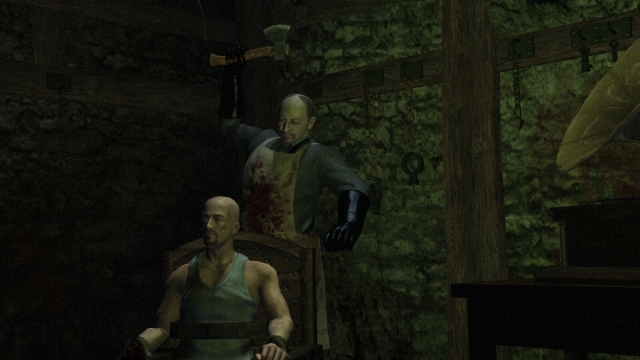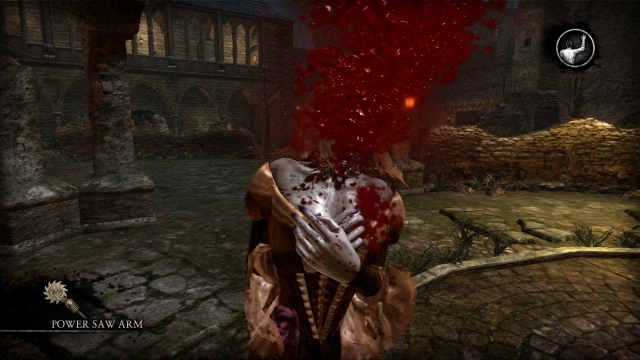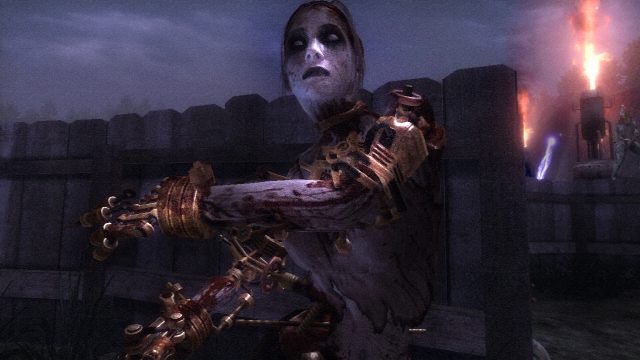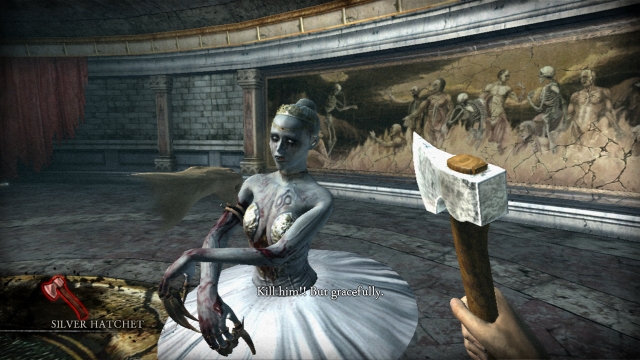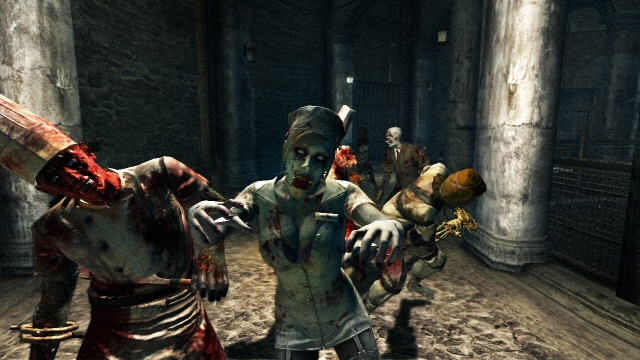Rise of Nightmares Review
Developer: SEGA AM1
Publisher: SEGA
Available on: Exclusively for Kinect on Xbox 360
Ever since its launch, Microsoft’s Kinect has struggled with the stereotypical image it garnered as being something aimed at children, and for having no serious games that the core audience would want to play. Well you can rely on SEGA to step in and do something different and unexpected. AM1, the team responsible for the hugely successful light gun series House of the Dead have brought us Rise of Nightmares, the first mature game for the Kinect device. Taking a lot of inspiration from said House of the Dead games, how does the gameplay make its transition from controller based play to the controller free arena? Might this be the start of a new wave of Kinect experiences?
STORY: After suffering from marital difficulties, Kate and Josh are on a tour of Europe in the hopes that it will help their relationship. We join them as they are aboard a train passing through Romania. The problem is, Josh has a drinking problem, and that’s where a lot of the couple’s issues have stemmed from. On board, Kate discovers Josh is still drinking and storms off.
It is here we take control of Josh and get to explore the train a little. Soon you realise that things aren’t quite right on this train. A strange reflection in the bathroom mirror, a terrified young Fortune Teller and some other shady looking passengers put you on edge, but it is when you see Kate disappear into a far away carriage with a mysterious man that you begin to worry. One blood stained carriage later and a hulk of a man known as Ernst has carried Kate away and the train crashes into a river as it goes out of control.
Here is where the game really begins. Kate is gone, the other train passengers are veing bumped off every five seconds and you find yourself heading towards the mysterious mansion of Dr Viktor and his wife Mary – who isn’t all that she seems. You now spend the rest of the game tracking Kate down, and trying to find out who is behind the strange abduction and a series of grotesque deaths and medical experiments, that are centered around the large house. There are many twists and turns in the story along the way and the developers don’t miss out on the chance to make use of a flurry of horror cliches.
Sure, the writing is hackneyed and the situations have been seen a million times before – not to mention the terribly cheesy dialogue – but this is all in keeping with the b-movie house of the dead style, and the silliness actually takes the edge off some of the pretty gruesome deaths and gore.
GRAPHICS: The game isn’t going to win any awards or break new ground, but the graphics are solid and fit the game well. Character models are quite realistic, but nowhere near the likes of L.A. Noire, though they maintain a lot of character as the facial expressions are somewhat exaggerated. Animation of the NPC’s is also a little over the top and over dramatic, but this is suitable for a schlock horror story, as in the movies, horror actors are liable to ham it up. Enemies are suitably gruesome and bloody limbs fly left right and centre as players hack away at them. This is far from realistic, but after making the House of the Dead games, AM1 knows what their fans like to see, and silly amounts of blood and guts is part of that.
Environments are really explorable locations and have been fully rendered in 3D. They arent massively high in definition, but try to add to the creepy, decrepid atmosphere and the gloomy locations really create a sense of foreboding, but also make you feel like you have freedom to wander. Although in reality, players are restricted in the areas you can explore and the directions you can go in – the exploration is still quite linear, like their shooter titles, but the illusion of freedom is there.
SOUND: The music is often too manic and modern, which doesn’t necessarily tie in well with a suspenseful game set in an old mansion. It is largely electronica which is obviously intended to get the blood pumping during battles, but it more often than not becomes irritating and over the top – although once again, this might be intentional as the whole experience has been created in this way.
Sound effects are suitably squelchy and the blood splatters and sound of an arm being lopped off are all satisfyingly visceral. But it is the Voiceover work that really grates at times. As the game is set in Europe, we experience quite a few different accents and characters speaking various accents. French, German and Romanian characters are amongst them, and whilst the Romanian language speaking ones seem convincing enough, it is the German and French characters who are forced to speak in English who are far from it. They aren’t helped much by the weak script and constantly cheesy horror dialogue. Whilst not technically well casted or written, I imagine this too, is intentional. It must be, as it suits the horror aesthetic perfectly. How many horror films are set in obscure European countries with the victims struggling with language issues? It is just another horror cliche that the game utilises as a strength, which is why the game was marketed with trailers and adverts which stressed the comedy elements.
GAMEPLAY: The gameplay itself is where the game finally stops simply perpetuating trends and tries to strike out into new territory. The Kinect based controls for the title are truly innovative and no previous game on the motion control accessory has allowed for such a free roaming experience. Whilst at heart the game remains quite close to the light gun games the company is famous for, guns are replaced by melee weapons and the occasional projectile. The more tactile idea of melee weapons is a much better fit for a game that is controlled with the movement of your hands and body, and this switch makes perfect sense. The aim of the game is simple, save your wife whilst destroying all enemies in your way and avoiding death-traps.
For those of you who were unaware, the players turns their shoulders from left to right in order to turn in-game, and places one foot forward in order to move forward. Place that foot slightly forward for slow movement and further forward in order to walk faster. This all makes sense, and is very responsive. Perhaps a little too responsive! Early on, players are very likely to find themselves over-steering when trying to turn or look at something in particular. Couple this with the fact that to stop walking you would normally stand still – whereas here you have to remember to move your foot back and stand with both feet together to stop going forward. This will result in many encounters with walls and walking into dead ends accidentally. This will obviously improve the more you play, and movement sensitivity thankfully can be adjusted in the options menu, but the feeling that you don’t quite have full control of the character will never quite leave you. The feeling of not having control is also illustrated well in some of the booby trapped rooms. Whereas a room with spinning blades would be rather easy to navigate with an analogue stick, here it becomes a whole challenge in itself, and the designers obviously added these rooms for just that reason. They are less about quickly dodging traps and more about being able to successfully turn and walk forward, without hitting an obstacle.
The game starts with a short tutorial sequence (known as Act 0) and throws you into controlling Max, another of the passengers on the train. At this point, you have yet to learn anything of the story and as far as the player knows, this is the main game already. This section teaches you all of the basics of movement as well as the auto-move feature. This option – where the player holds their right fist in the air – makes the character follow the automatic route towards the next objective. This is great for when you get lost, or are having particular difficulty in navigating a certain corridor. It also works well on the occasions that you find yourself hitting against a wall.
The tutorial also teaches the player to perform interactions – where pushing forward with their palm will trigger the opportunity to perform a gesture based action. These include pushing open closed doors, turning valve wheels and swimming through water. These actions are all logical and intuitive – for instance, when escaping the crashed train, if the game tells you to run because the train is unstable, you simply run on the spot as you would in real life. This also leads to another issue with movement however. If, when the player enters an interaction, their foot is forward for movement – and you don’t return it to standing position during the interaction – when the gesture is completed, the on-screen character will start reversing, as if you are performing a back-step. This is obviously an issue with tracking the position of your feet before and after an interaction, and doesn’t occur every time – but it can be annoying to find yourself reversing, and you will have to set your feet back to standing position for a moment before the game will stop.
Finally you are taught fighting, which is also very straightforward. Put your hands up like a boxer to enter fight mode (which will also auto-lock on to nearby targets), then swing your arms to punch if your hands are empty, or to use a weapon if you have one. Weapon attacks can be directed, so you can try to chop off the left or right arms, or aim for the head. This aiming isn’t perfect, but does offer a degree of freedom of movement in attacks. There are several projectile weapons, which you simply perform a throwing action to operate – the fighting system is very natural, albeit a bit tiring, having to hold your arms up for extended periods of time. Blocking is easy, simply hold your arms up over your face, and a block will be performed. The attack system was easy to pick up and a lot of fun to execute – although a greater variety in the attacking moves would have been nice – perhaps in a sequel? Some basic head tracking is implemented, meaning during cut-scenes and other moments, looking up and down will makes the camera pan upwards and downwards slightly, which is a nice extra touch.
The last two gameplay features illustrate both the basic and the inventive. There are quite a few quick time events in the game. You might enter a room and poison darts are aimed straight at you. Duck quickly or you receive instant death and must restart from the closest checkpoint. Lives are not an issue, you simply have to go back a few minutes to the last save. So, “duck” will flash on-screen and you have a short time to perform the action. This is a basic idea, but works quite well in practice. The problem is, some of these events are so sudden and unforgiving, that there is no chance you would pass it first time. These quick time event actions also occur within boss battles and make up the bulk of the final boss fight. The boss fights aren’t much more complicated than general fighting though, simply with more blocking – so unfortunately they offer little variety in the game. This is an overall issue, as you fight the same enemies for most of the game, with little change. Some have armour, so are harder to beat, and you have to aim at exposed body parts, but on the whole the enemies are all of equal strength, throughout the entire game.
There is another, more inventive gameplay element. The hulking monster, Ernst, is sensitive to sound. Stay quiet and still and he cannot see you on the rare occasions when he appears and you have nowhere to run. Obviously, you can’t just stand in his path – but move to the side, or behind a cabinet and stay perfectly still, and he will pass you by. Few games make use of the idea of just not moving at all, and this adds a really interesting element to the game. On top of this, some singing enemies can be beaten by simply putting your hands over your ears whilst approaching them, before quickly dispatching them. These little elements, which make a lot of real life sense in terms of their execution, are the elements of the game that show the most promise and the more inventive aspects of the game design.
LONGEVITY: The game features a selection of collectables for you to find hidden throughout the game world. Tapes left behind by a Detective investigating Viktor fill in gaps in the back story of the game, and help make sense of what you come across. There are also Tarot Cards left behind by the fortune teller, which you can find. All of these items can be viewed in the main menus. Upon completing the game on either of the two difficulties, you unlock a third, harder one – which may make you play the game again for a bigger challenge and to earn the higher difficulty achievement points. The game will need several playthroughs to get all of those achievements, so some people will want to come back and play it all again, although others will find the lack of variety and basic story to have been enough the first time around.
The final addition is a gauntlet style endless nightmare mode, known as “Act 10”. This mode has several stages (each more difficult than the previous one) where the player is given a time limit in which to escape the area they are thrown into, killing as many enemies as they can along the way. They will then be scored and given a grade to measure how well they have done, and this really encourages the player to keep coming back to beat their scores. Unfortunately, the lack of online or friends leaderboards means that you can’t compare and try to beat other people’s scores, as well as your own. There are no online features at all for that matter.
VERDICT: Rise of Nightmares does a lot which should be praised, and really pushes forward the idea of what can be done within a Kinect title. Not everything is successful, and some features will frustrate and irritate, but the experience is unlike any other on the console. SEGA should be commended for their work, and the title provides a lot of fun moments – albeit something that may have been more at home in the arcades, where House of the Dead became so popular.
The game ends up being quite a short affair, clocking in at little over five hours, but those five hours include more imagination, and one-of-a-kind experiences than any other Kinect title. Get past the control niggles and the game is a lot of fun, and the fighting system performs admirably. Fans of cheesy horror and violence have finally got a motion control game worthy of their attention, and it certainly isn’t a Nightmare to play, but walking into walls may give you some bad dreams.



